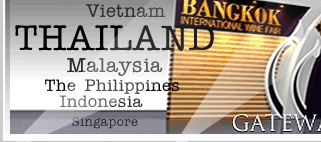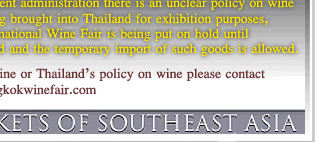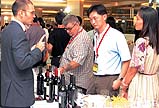
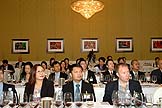
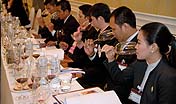
Wine and Contemporary Thai Cuisine
at the Bangkok International Wine Fair 2010
What is Contemporary Thai Cuisine?
The Thai culinary tradition is long established, and some of the most familiar dishes in the Thai
repertoire are classics which date back many centuries. However Thai cuisine, like French and Italian,
is not a culinary museum-piece – it is a living tradition responding to changes in the world about it.
Not least of these are the availability of ingredients previously unknown in Thailand, and Thais’
increasing familiarity with (and appreciation of) the cuisines of other cultures.
Essentially, Contemporary Thai cuisine is the adaptation of traditional Thai dishes (or cooking styles)
to imported non-traditional ingredients - such as Italian pasta, New Zealand lamb, Australian Wagu beef,
Dutch veal, French foie gras, Maine lobster, Norwegian salmon, Alaskan King crab and a host of others.
As such ingredients are expensive, contemporary Thai cuisine is very much the preserve of the
fine-dining scene at present, and the talented chefs who prepare such dishes cater for sophisticated
diners who are also familiar with the world’s other major cuisines, both Oriental and Western.
Naturally, the international fine-dining style has considerable influence on the presentation of dishes,
and so does the likelihood that they will be accompanied by wine. Ensuring a successful match
with wine is therefore a key consideration for chefs working on innovative Thai dishes in this area.
For all these foreign influences, Contemporary Thai chefs insist that their concoctions are merely
natural developments and extensions of a native Thai tradition which is broadening its horizons.
Such cuisine should not be confused with ‘fusion’, which deliberately seeks to blend different culinary
traditions. There is no shortage of fusion cuisine in Thailand, and this is also consumed with wine,
but although it may well incorporate Thai ingredients and some elements of traditional Thai cooking
styles, this kind of ‘multicultural’ food is something quite different. In contemporary Thai cuisine,
foreign influences are certainly welcomed, but strictly on Thai terms.
Of course, at the same time as Thailand is importing and adapting its cuisine to new ingredients from
around the world, so are other countries adapting their own cuisines to new ingredients from Thailand.
The recent explosion of Thai restaurants abroad, especially in the English-speaking world, has not only
made Thai ingredients much more readily available in many countries, but has also quickened the
interest of chefs in the possibilities of such things as lemongrass, coconut cream, Homali (fragrant) rice,
sticky rice, long-grained brown rice, fish sauce, fresh chillies, green, red, panaeng, mussaman and
jungle curry pastes, kaffir leaves, galangang, tamarind - and many other Thai products which were once
considered wildly exotic. Slowly but surely, these are beginning to find their way into innovative
Western dishes – and one day, will no doubt become as securely domesticated as ginger, pepper
and cloves (not to mention the potato!) before them. There is nothing remotely new about the
adaptation of cuisines to previously unknown ingredients from afar.
Wine & Thai – Combining for Health
Thai cuisine has always been concerned with a healthy lifestyle – indeed the distinction between diet
and medicine in traditional Thai culture is much less clearly drawn than in many other cultures
(a huge range of natural herbs and spices is used in Thai cooking). The Buddhist striving for ‘balance’
in all things underlies both the preparation and serving of food, generally with highly beneficial effects.
Until the recent advent of Western fast food (many young Thais have certainly acquired a taste for
hamburgers, KFC and pizza), it was rare to see an obviously overweight Thai, and diet-related ailments
remain relatively uncommon. Thais have always eaten well in both senses of the word.
In the West, of course, people have also become acutely conscious of the importance of a healthy diet.
Traditional rustic diets and sedentary office lifestyles have proved a most unfortunate combination,
with the result that the culinary trend has long been towards lighter, less fatty food. In part, at least,
this explains the burgeoning popularity of Thai cuisine in the West in recent years. Thai dishes are not
only delicious, but are also recognised as falling well within the boundaries of ‘healthy eating’.
At the same time, wine has been attracting invreasing interest on health grounds. The argument that
wine (red wine in particular) is positively beneficial for health now has many medical and scientific
proponents. And while that case is not universally conceded, it is at least acknowledged that wine,
drunk in moderation, is almost certainly better for the system than hard liquor or large quantities of beer.
The same argument has attracted attention in Thailand. Thai men, in particular, are accustomed to
drinking strong spirits with their evening meals, and this undoubtedly takes its toll on those who socialise
frequently. The relative healthiness of wine is certainly one consideration for many upper-class Thais
who have changed their drinking habits in recent years, and it is no accident that at present red wine
is much more popular in Thailand than white.
In dietary terms, it follows that Thai cuisine and wine should be an unbeatable combination. Of course,
matters are not quite so simple. Many traditional Thai dishes are distinctly spicy (some ferociously so!),
and there are in any case difficulties matching wines in a food-service tradition which requires sharply
distinct flavours to be on the table simultaneously. One of the challenges accepted by chefs working
in the field of Contemporary Thai Cuisine has been to improve the compatibility of Thai dishes (or at least
some of them) with wine – this very foreign beverage which until now has obviously played no part at all
in the development of the Thai culinary tradition. At the same time (as with other Oriental cuisines
adapting themselves to the international fine-dining style), some compromise has been sought between
the food presentation traditions of East and West.
Contemporary Thai Cuisine at the BIWF
During the three days of the show, the Bangkok International Wine Fair will stage several culinary
presentations in accordance with our theme ‘Wine with Contemporary Thai Cuisine’. These will involve
the live preparation by celebrity chefs of innovative Thai dishes that incorporate both Thai ingredients
and others imported from the world’s major wine-producing regions. Moreover, wine styles which have
been found to pair successfully with these dishes will be recommended, and will be made available
for free public tasting. Both the food preparation and wine-pairing will be presented in Thai and English.
Following the fair, BIWF will be hosting a Gala Dinner for some 300 people at one of Bangkok’s leading
5-star hotels. This will be a 9-course gourmet feast, featuring dishes from those prepared at the show,
together with a range of 9 fine wines from around the world - expertly selected to complement the food,
and presented to diners by the winemakers or producers. It is our ambition that the BIWF Gala Dinner
will be one of the most prestigious culinary events ever held in Bangkok, and serve as a launch-pad for
contemporary Thai cuisine in the world at large. In due course, a book will be published for international
distribution featuring the recipes of all the dishes created for the Bangkok International Wine Fair.
- Programmes and Seminars
- Wine with Contemporary Thai Cuisine
- Thailand’s Best Sommelier 2010
- Thailand Wine News
- Show News
- Map : Mainland SE Asia
- BIWF Wine Challenge



